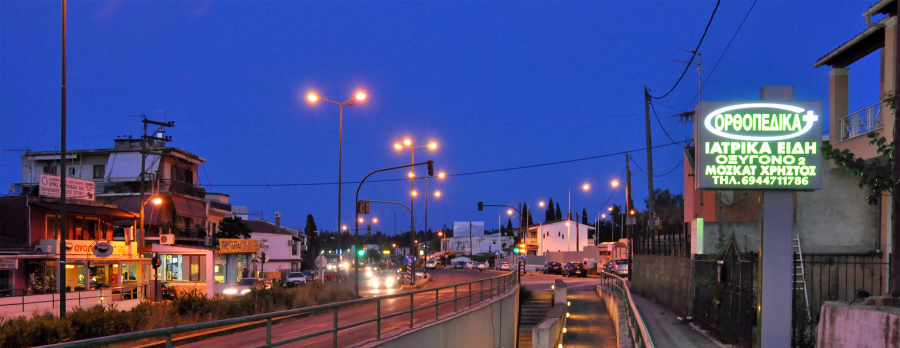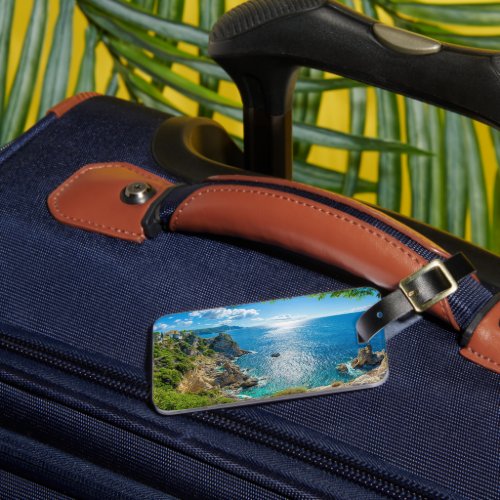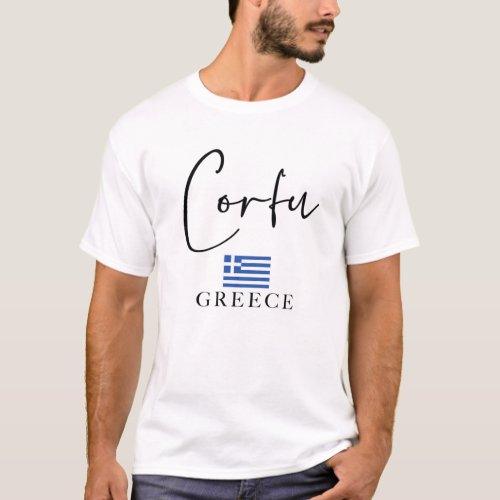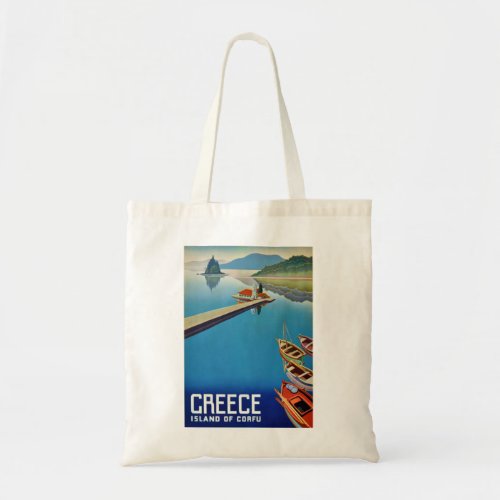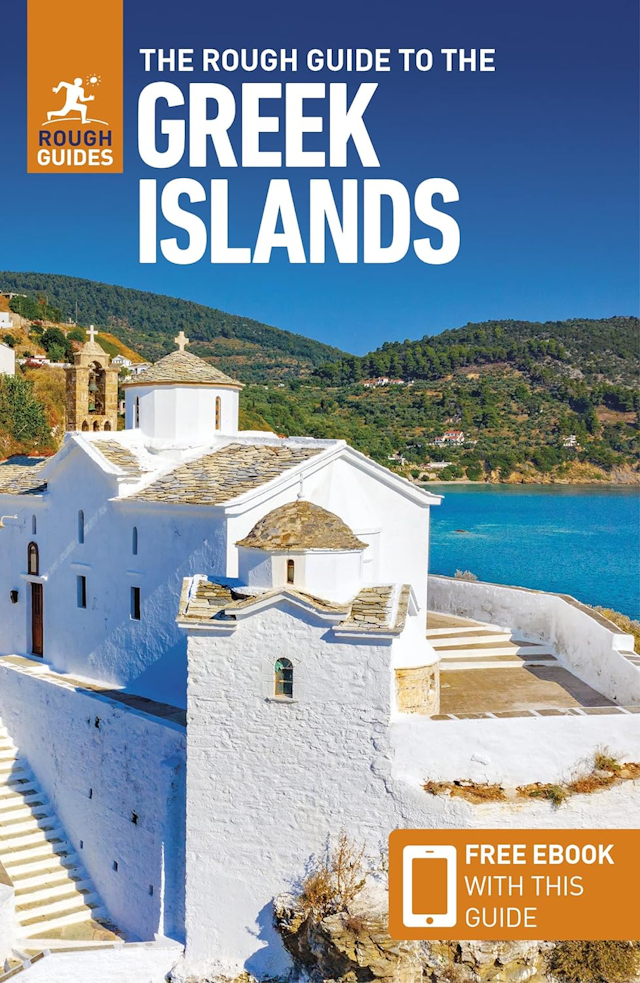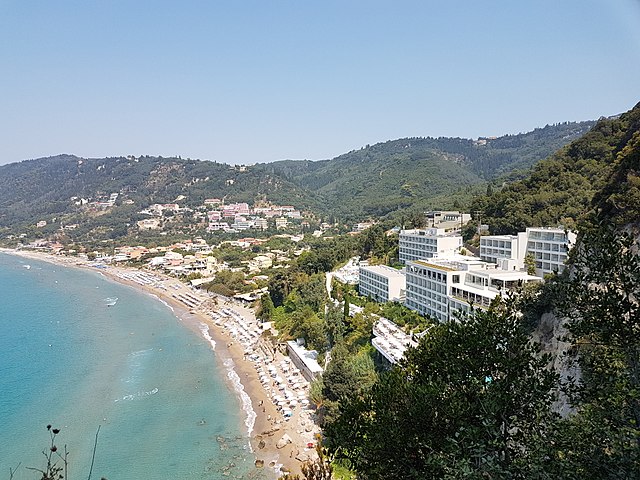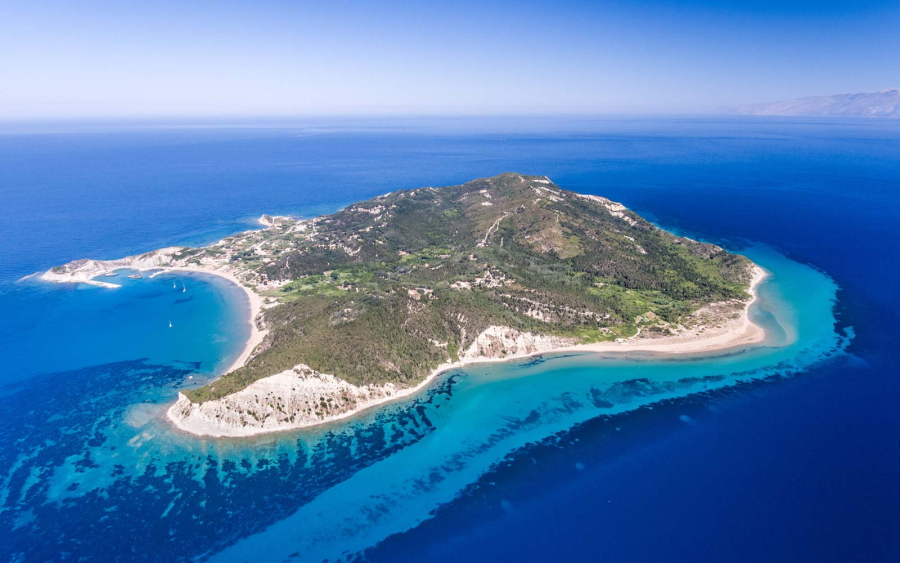- HOME
- Ionian Islands
- Corfu
- Northern Corfu Beaches and Villages
Northern Corfu Beaches and Villages
Northern Corfu’s beaches and villages include busy resorts and secluded beaches, with several hill and mountain villages well worth visiting.
This file is licensed under the Creative Commons Attribution 3.0 Unported license.
Kontókali
As you head north from Corfu Town the first resort you reach after about a 15-minute drive is Kontókali. It's an understandably busy and popular place but still with a bit more character about it then some of the others further along around this bay. It merges into the marina at Gouviá, and this attracts a fairly well-heeled crowd and keeps the place prosperous, where others further north rely on mass-market tourism and all that this brings with it.
The beaches here are nothing special, but there is a lively air in the back streets between the marina and the main coastal road. Here you'll find some attractive old houses, draped with bougainvillea as well as old-fashioned eating places away from the smarter fish tavernas down near the marina. There is a very limited amount of accommodation, though, as most visitors either stay on their own boats or are locals with boats moored in the marina.
Gouviá
There is no discernible gap between Gouviá and Kontókali, but Gouviá is where the marina is, and where boats have been built and repaired for many years, as the remains of an old Venetian boatyard prove. This is signposted down near the waterfront and close to the modern marina. In the face of all the development, these surviving remnants have an ancient dignity about them.
This file is licensed under the Creative Commons Attribution 3.0 Unported license.
As with Kontókali, there's still a flavour of the old town in the back streets of Gouviá, which can get lively at night, and there are also some smart and expensive fish restaurants down by the waterfront. From here there is also a pleasing view of the Holy Church of the Ipapandi at Komméno across the water.
Dasiá
Continuing north, Dasiá is not quite as smart as Gouviá. Here the busy coast road is lined with the bars, cafés, clubs, shops and tavernas that appeal to the international holidaymakers who flock here. The road is at least away from the beach, and several side roads lead past hotels and apartment buildings down to the water.
If you are interested in culture, though, then inland from here in the village of Káto Korakiána is an Athens outpost by way of the National Gallery Annex of Corfu. A large white-walled open gallery downstairs has a small but interesting core collection, while exhibitions are sometimes also on display in other areas.
Some Cool Corfu Souvenirs
Ýpsos
Beyond Dasiá, the coast road dips down and runs alongside the beach in the very commercial resort of Ýpsos. The grey shingle beach isn't particularly attractive or wide, but it does run for a long way around the pretty bay here. The appeal is marred, though, by the roar of the traffic and the fact that you have to cross the road to get to and from the row of shops, tavernas and bars on the far side.
At night the traffic noise competes with the blare coming out of the clubs and discos, as the town is popular with young people who like to dance the night away. During the day the action switches to the beach, where there are plenty of watersports to keep people occupied... those who aren't merely sleeping off the night before, that is.
Pyrgí
These days Pyrgí and Ýpsos are hard to tell apart, with Pyrgí occupying the northern end of the same large bay, just where the coast road climbs and sweeps to the east to be squeezed between the mountains and the sea. The beach at this northern end is sandier than further along, and with an existence apart from the beach, Pyrgí could make a good base if your interest is more in walking than nightclubbing.
From here there is fairly easy access to the lower slopes of Mount Pantókrator and some of the inland villages, though its appeal as a resort is still more to the barfly and the beach bum than to anyone interested in the real Corfu.
Barbáti
At Barbáti the east coast landscape changes as the island bulges out to accommodate the bulk of Mt Pantókrator, and the road that links the east coast resorts like pearls on a necklace has to force its way between the plunging mountainside and the sea. It does this by staying high above the water, so that resorts like Barbáti are divided.
The main part of the town straddles the road while paths and narrow roads lead down to the beach. The beach here is popular with parents as it has safe bathing and is well away from that busy road, as well as being long and wide, something the passing driver will not realise. There is the usual array of watersports for the more active, and up on the main road plenty of eating and drinking spots, though nothing like the dozens of discos and drinking dens that can be found further south.
Accommodation tends to be tucked away down the side roads, so you will have to venture off these if you want somewhere to stay, or try stopping at one of the travel agencies which are dotted along the main road.
Nisáki
Nisáki spreads along and below the coast road, but has no real centre to it as the road zig-zags round bend after bend and the town zig-zags along with it. Side roads and paths lead down to bays, beaches and little harbours, where the tavernas prove popular with holidaymakers.
It is down these side streets that most of the accommodation is based, so if you are looking for somewhere to stay you will have to drive slowly and look for the usually narrow entrances to the roads which sometimes lead down quite steeply towards the sea.
There are many more shops and eating places along the main road, some of them surprisingly good, and the occasional car rental office and travel agency too. It may have no real centre but it does have a friendly, relaxed atmosphere and many visitors come here year after year.
Agní
Little Agní is the perfect place for a lunch by the sea, or a romantic evening meal, hidden away as it is at the end of a road that leads down from the coast road, and which until a few years ago could not even be driven all the way.
The cluster of excellent tavernas along the beach here would bring people in from the nearby resorts by water taxi, a service they still provide if you ring ahead and book. It’s well worth it, as the small bay with its pebble beach is truly idyllic, backed as it is by olive groves and vegetable patches and with paths leading off at either end towards other bays and beaches.
Kouloúra
Kouloúra should be on everyone's Corfu itinerary, as it is the perfect little secluded harbour, seemingly cut off from the world. There is a terrific view of it down from the coast road, with a pull-off viewpoint on the right of the road as you head north, and on a sunny day when the light is right it makes the ultimate picture-postcard shot. Naturally you will see it on postcards everywhere, and you will certainly want to stop and at least take a look.
This may be as close as you want to get unless you choose a quiet time, as when you weave your way down there you will find a solitary restaurant but not much solitude. Half of Corfu seems to want to eat here, especially on a Sunday lunchtime, and with people arriving by boat, and on boat excursions, you may prefer to settle for that photograph from above.
Ágios Stéfanos
Ágios Stéfanos is yet another perfect little bay, showing that there are plenty of places on Corfu for those who want to escape the crowds and enjoy a fairly quiet time in a beautiful setting. The beach curves around a wide bay, lined with whitewashed buildings, backed by olive groves and farmland which rises up gentle slopes, and with views across the water to the scenic beauty of Albania.
This is an excellent base for walking, and also for doing nothing except choose which of the several good tavernas to have lunch or dinner in while watching the boats bobbing in the deep blue waters.
Andinióti Lagoon
Although only fairly small, the lagoon is an important wetland area and should be on the itinerary of anyone interested in wildlife. It was a place that was very familiar to Gerald Durrell when he was growing up on Corfu. Head for the church of Ágios Spyrídon, where there is also a taverna and a small sandy beach, and from here a path leads into the area around the lagoon.
If you're lucky you might see herons and hawks, waders and warblers, and may even hear the sound of the nightingale. There are terrapins in the water, which children always love spotting, and an hour or two here makes a welcome contrast to the busy holiday resorts all around.
Acharávi
Acharávi used to be swampland, reclaimed from the sea, and as recently as 1979 there was only one taverna in the village. Today it has become a very popular resort, particularly for families, though first impressions may not always be favourable. If you drive along the main coast road through the town, you see the usual strip of bars, restaurants, travel agencies, and souvenir shops.
Once you get off the main road, though, and down the side streets, the charm and character of Acharávi start to reveal themselves. There’s an excellent, long, sand and shingle beach with safe bathing for young children and lots of watersports for older children and adults. In the evening the bars and restaurants come alive, though not in the same rowdy way that they do in other resorts. There's plenty of fun, entertainment and good food and drink to be had, but not to the extent that it spoils the town.
Róda
This file is licensed under the Creative Commons Attribution 3.0 Unported license.
Róda is another of the north coast resorts that has developed rapidly since tourism came to town. It has a decent if unspectacular sandy beach, and behind this is a row of restaurants, souvenir shops and bars, several aimed at the British holiday market with showings of sport and TV shows, and karaoke contests. This lets you now that Róda has a lively nightlife, but it is still fairly small compared to places like Kassiópi and Sidári. The beach is well away from the main road, which runs through the town centre, so it is also popular with families.
Astrakerí
Astrakerí has a beach that's a mix of sand and pebble, a jetty, a huge parking area, a few tavernas, and some accommodation in the summer months. At the moment it attracts mostly day visitors, keen to find a beach which usually has a bit of space on it.
Karousádes
Most people miss the village of Karousádes, as the main road between Róda and Sidári zips by it without entering the centre. Look for the signs, though, as you can enter it from either direction, up quite a steep hill.
You'll then find yourself in a lovely traditional village with an 18th-century pink-domed church and its more modern clock tower, some delightful old houses, and beautiful views inland over the hills and valleys. There is even good car parking space at the east end of the village, helping to make it an easy stop for a break and a look around.
Don't miss our Northern Corfu Drive!
Perítheia
Old Perítheia is signposted from the northern coast road, and until fairly recently was a virtually abandoned Byzantine/Venetian mountain village that was inaccessible unless you had a rugged vehicle. Now the road has been improved for most of the way, although the last stretch is still a little bumpy but the average car can cope.
It’s now become something of a tourist attraction, as the village has started to regenerate itself and people have moved back in to renovate the lovely old stone houses, and there are a few tavernas and cafés too, catering for the more adventurous souls who get up here.
It’s a great place to wander round, especially for photographers, with the old buildings and their doorways and shutters oozing atmosphere. Walk out of the village and follow the rough road around and above it, to get more good views looking back over the rooftops.
Latest Posts
-
The Lesser-Known Traditions of Greek Easter
Step off the beaten path this spring and discover the enchanting — and often surprising — Easter traditions found across Greece. -
Easter in the Mystical Castle of Monemvasia
In the castle town of Monemvasia, with its dramatic medieval backdrop and sea views, Easter is a deeply spiritual and atmospheric experience. -
Sifnos: Greece’s Hidden Culinary Star on the Rise
Sifnos, a Cycladic island, is gaining fame for its rich culinary heritage, especially the beloved melopita honey-cheese tart. -
Easter in Leonidio: A Tapestry of Light, Culture and Cliffs
In Leonidio, Easter comes alive with handmade hot air balloons in the sky and lanterns made from bitter oranges in the streets. -
April 9 Strike in Greece to Impact Public Transport, Ferries and Air Travel
Transportation and travel across Greece will face disruptions on Wednesday, April 9, as public transport, ferry and aviation workers join a nationwide strike called by Greek labor unions. -
Ancient Theater of Lefkada Brought Fully to Light Following Systematic Excavation
The Greek Culture Ministry has announced that the first ancient theater ever identified in the Ionian Islands has recently been brought fully to light on Lefkada, revealing an impressive monument that… -
Seven Greek Traditions Recognized as Intangible Cultural Heritage
From traditional barrel-making to age-old folk dances, seven new entries on Greece’s National Inventory preserve the country’s living heritage for future generations. -
Greek Air Traffic Controllers to Hold 24-hour Strike, Disrupting Flights on April 9
The Hellenic Air Traffic Controllers Union have announced a 24-hour strike for Wednesday, April 9, in response to the protest called by the Civil Servants’ Confederation (ADEDY). The strike is being h… -
Ten Best Budget Hotels on Santorini
Greece Travel Secrets picks the ten best budget hotels on Santorini, some with caldera views, some near beaches and some close to the heart of Fira. -
No Ferries in Greece on April 9 as Seamen Join Nationwide Strike
The Pan-Hellenic Seamen’s Federation (PNO) has announced its participation in the 24-hour strike called by the General Confederation of Greek Labor (GSEE) on Wednesday, April 9. The strike, which will…
